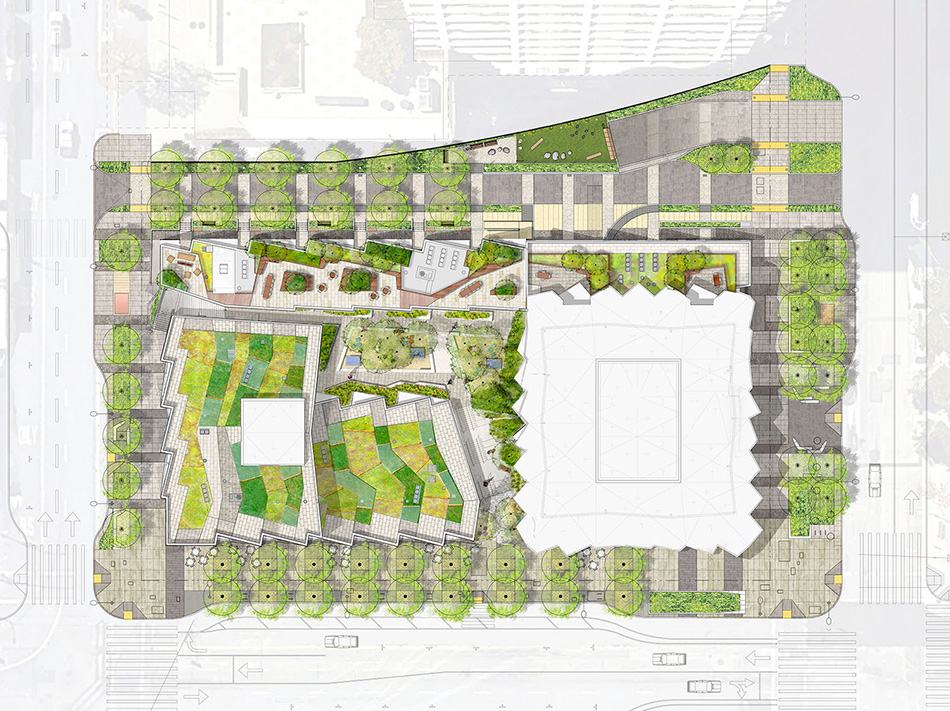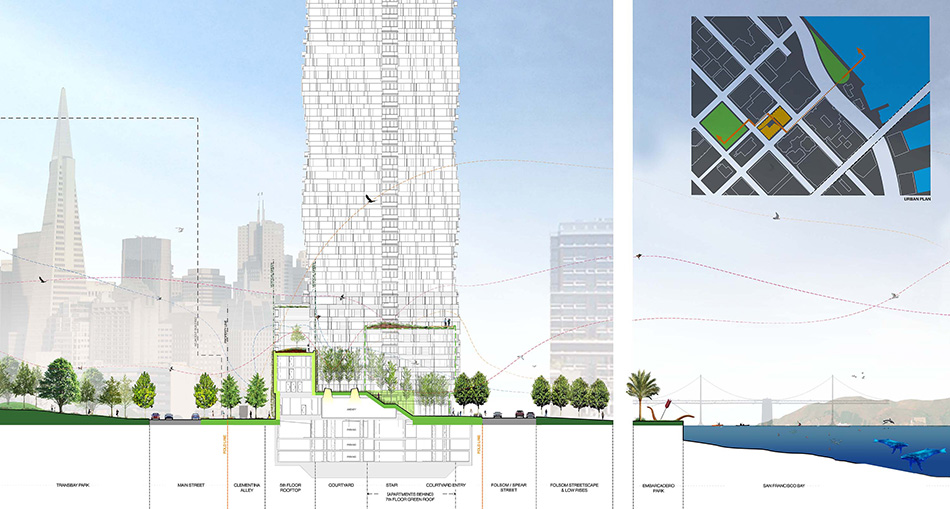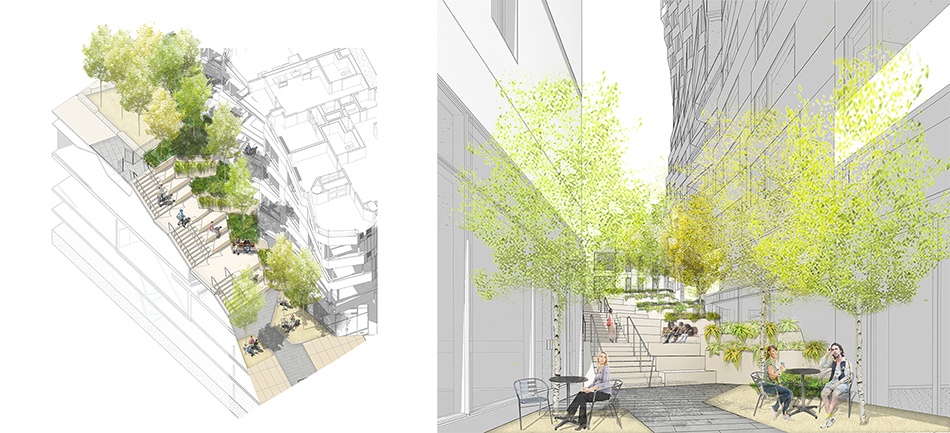This unique development is a key urban ecological linkage in the transformation of the Transbay neighborhood from transit infrastructure to community. Centering on the word ‘ecology’ and its original Greek sense of “house” or “environment”, the project encourages interactions, engaging biological systems in complex living relationships and generating diversity. A new system of shared streets and pedestrian amenities provide much needed nature and respite. This city block expands upwards as a dense vertical “neighborhood”, and as designers we were very aware of the 5th Elevation – that is, how this project is understood from above – from the “Bird’s Eye View”. These multiple roof tops are designed as a landscape of elevated grounds, all vegetated for residents to enjoy, and as a shared resource with the native ecology of the Bay Area, with seasonality, planting diversity, habitat potential, and stormwater management – all watered by reclaimed grey water generated by the residents themselves.

The MIRASF Landscape
There is over 54,000 square feet (over a 1 acre) of open space on 5 levels, it is a new vertical neighborhood; equivalent to 16 blocks of single family homes in a typical city, all in a one block complex. The landscape design aspires to balance human development with ecological benefit, through a shared design language of building and landscape that creates a vibrant, urban environment characteristic of downtown San Francisco, contrasting complementary spaces, both extroverted and introverted, comforting and vibrant, timeless and contemporary, diverse and simple, durable and tactile.
 Conceptual Site Section
Conceptual Site Section
INTERSTICE’s early sectional drawing, “Ecological Corridor Concept”, illustrates the connection from Embarcadero to the Transbay Park and to the new Transit Center (Salesforce Park) beyond. The site design focuses on native species and habitat that serve native hummingbird and insect populations through careful plant species selection for food and nesting sources, and includes elements on the uppermost roofs that serve as micro-habitat, in the form of dozens of natural logs embedded in the living roofs, providing cover as they naturally decompose over time.
Streetscape
The streetscape design re-imagines Folsom street as pedestrian-prioritized boulevard with tree-lined widened sidewalks, commercial activity, rain gardens, seating, bike lanes and other amenities and safety improvements. The new Clementina Alleyway POPOS is an unusual opportunity to create an intimately scaled shared street connecting this new vertical neighborhood to the Embarcadero. A front door to new homes, this green, plant-lined habitat corridor, widens to the east, where the lane creates the Clementina Commons – an intimate open space with seating for people and their pets.
Level 2 Podium Courtyard – “The Nest”
This elevated podium-level courtyard is the protected “heart” of the residential complex with a grove of slender Himalayan Birch trees with a fern understory that is accessed from Folsom Street by a broad stair. The Tribune Stair is a series of terraced platforms that rises like a folded alleyway between building volumes, creating a terraced forest leading from the “eddy” plaza space off this busy retail corridor. This cascading landscape is an invitation to sit and linger perched where one can see the street level commercial activity.
The quiet “forest” at the foot of the Tower is the residential entry to the second level town-home units, and is a dynamic visual focus, for all the surrounding, units, town homes and tower. This green oasis of open foliage trees draw light and movement through their bright canopies deep into the space. The white birch bark and seasonal foliage reflect light and animate the court as bright green summer foliage changes to yellow in autumn, then opens up to a tracery of fine white branches through the darker winter months; lighting the lush fern understory, of textured seat walls and variegated paving stones.
Materials are soft in color, smooth and refined, with carefully detailed joints and recessed lighting with perimeter planters of lush plantings that provide privacy to surrounding living spaces, and informal seating ledges near unit entry doors. Large sky-lights connecting the indoor gymnasium below are purposefully expressed as oversize “lanterns” that emerge from below the forest floor to glow at night.
Greenroofs – “The Ledge” and “The Perch”
The upper level roofs are living roofs, that while providing a visual amenity from above, are actually very alive, and contribute a significant ecological and sustainability asset to the project. In addition to cooling the building, and extending the life of the roof, these mini habitats form part of the storm water management system by slowing and retaining rainwater. Selected species are native and adapted plants that create an ecology for hummingbirds and other native bird species, and numerous insects on down the web. Here banded patterns of varying foliage color and texture are intermixed with seasonal blooms, and divided by massive logs of wood that slowly decompose over decades to maintain plant types and enhance ecological habitat. The soil media depth of 8″ supports sedum species and smaller perennials, while deeper soils of 18″ at level 7, allow for more varied planting selections of taller sedums, grasses, shrubs and even small trees.
Level 5 Shared Amenity Space – “The Wing”
In contrast to the inner sanctum of the central court Level 5 is a more extroverted space. The Wing is the primary shared Social Gathering Space. Laid out as a linear progression of enfilade outdoor “rooms” contained within the embrace of raised meadow plantings and warm wood divider walls. The first “room” directly adjacent to the interior common lounge, is an outdoor dining area, furnished with a perimeter of large built-in benches. The next is the “entertaining” room serving flexible uses, overlooking the level 2 courtyard Birch grove, with communal tables, two outdoor kitchens, moody evening lighting and plentiful seating. The western-most “room” is a glass protected promontory with sunset view over Transbay Park. Separated from the rest of the rooms it is the most private and enclosed, for more intimate evening gatherings around a linear outdoor fireplace, with cozy furnishings and glowing floor lamps.

Location: South Market District, San Francisco
Owner/Client: Tishman Speyer / Studio Gang Architects
Scope: Landscape & Streetscape, design through Construction
Status: Completed 2020
Photography: Bruce Damonte
Leave a Reply
You must be logged in to post a comment.
